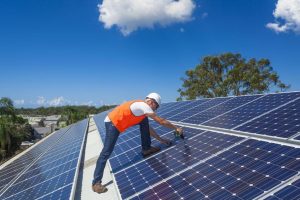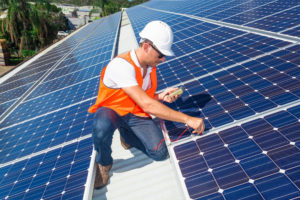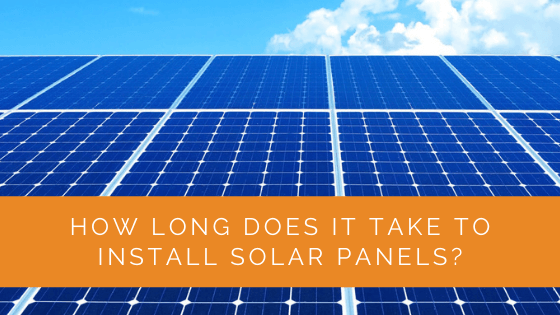As people are growing conscious of the planet and its resources, clean energy sources, such as solar energy, are getting all the attention.
If you, too, are planning on installing a solar panel system, you might be wondering about a lot of things. Solar panels are expected to last you for decades, so you should carefully evaluate any decisions related to them.
Installing solar panels is a long-drawn process that needs proper time and attention. It is not as simple as just buying the equipment and mounting it onto your roof.
Let us look at how long it takes to install solar panels and what factors could potentially impact the process.
Contents
- 1 Key Takeaways
- 2 How Long Does Installing a Solar Panel Takes from Start to Finish?
- 3 What Factors Affect the Duration of Installing Solar Panels?
- 4 Case Study: Streamlining the Solar Panel Installation Process for Efficiency
- 5 Expert Insights From Our Solar Panel Installers About How Long It Takes To Install Solar Panels
- 6 Experience Solar Excellence with Us!
- 7 Finishing Thoughts
Key Takeaways
- Installing solar panels is a multi-step process that can take around 2 to 3 months from start to finish.
- Key steps in the installation process include finding contractors, reviewing proposals, site visits, signing contracts, obtaining permits, and conducting technical inspections.
- Various factors such as the size of the solar panel system, the expertise of the crew, weather conditions, local authorities’ efficiency, and utility company processes can influence the duration of the installation.
How Long Does Installing a Solar Panel Takes from Start to Finish?
The process of installing a solar panel begins long before the actual physical work. Selecting contractors, obtaining permissions are all part of the process.
Each step within the solar panel installation process could take days. Here are the different steps that you need to follow to install solar panels.
1. Find Contractors
The first step in getting solar panels is reaching out to several contractors. You should look for an certified company to do the job.
Certification ensures that the company upholds high standards and can guarantee quality.
It might take you a few days to find contractors with experience and a strong track record. Do not just find a guy with a truck that promises he can install your solar panels. Instead, look at online reviews and testimonials to find good services.

2. Inspect Proposals
After identifying prospective contractors, you need to review their proposals for the solar project. A proposal should encapsulate a basic diagram, positioning of the inverter, meter, wiring, and other necessary information.
While some contractors prefer to design a proposal only after a site visit, many companies do so with the help of satellite images. Moreover, some companies can even fly a drone over your house to capture the roof.
This step might take a few days. You can then review the proposals from different contractors and understand important things such as warranties, equipment, mounting, etc.
3. Site Visit
A technical site visit is imperative for the contractor to get the lay of the land. Satellite images and drones cannot detect everything. Hence, the contractor needs to inspect your roof to identify any issues or changes required.
Some contractors might not offer a visit unless you sign with them. If you find a contractor who insists on signing first and visiting later, ensure that your contract allows you to back out after the visit without any hidden charges.
If you have any questions about the entire installation process, this is a good time to ask your contractor and clear up your doubts.
The actual time needed here is just a few hours. However, you might spend a few days arranging visits.
4. Signing the Contract
Once you’ve decided which contractor you want to go ahead with, it’s time to draw up a contract. Ensure that both parties are on the same page before anyone signs the deal.
It might take a few days to clear out the terms, but you should only sign when you understand all the terms and agree to them. Stay away from contractors that try to pressure you into signing the contract.
5. Applying for Permits and Incentives
This step in the process is crucial and may even take up to a few weeks. While contractors usually handle all of it, you should be aware of all the permits you require and the incentives available.
Many local and state bodies offer incentive plans to motivate residents to switch to cleaner energy sources.
You will need permission from your utility company before connecting a solar panel system to the electricity grid.
Additionally, you also need to obtain some permits from your local governing body, such as electrical permits and structural permits.
How long this step takes is completely dependent upon how quickly your local authorities function. In some cases, it might even take a few months.
6. Technical Inspection
When you apply for permits, you should be ready for an inspection by the authorities. A structural engineer or an architect might come over to examine your roof or even other parts of your house.
While the actual inspection doesn’t take a long time, scheduling it might take a few days.

7. Solar Panel Installation
Alas, the heavy lifting begins! That step is the essence of the entire process and can be done in a matter of hours or a couple of days at most.
You do not need to worry much about this part because contractors have lots of experience and can get the job done in the best manner possible. They will bring in all of the equipment required and get to work.
8. Meter Installation
You will need a new meter, depending on your current scheme with the utility company. The company may decide to send in their own employee or allow your contractor to do the work.
This process, too, should not take much time. The only reason it could take a few days is to work out a schedule.
9. Final Inspection and Activation
Once everything gets set up, you just need to be a little patient and let the city inspector or utility company perform a final inspection. In some cases, both parties might be required to do so.
That could take a few days, depending upon the people working at the local offices.
After your solar panel system gets approved, you are free to flip the switch and begin using it.
All said and done, the process of installing a solar panel might take two to three months in total. However, you do need to be active through all of the steps. A lot of the work gets handled by the contractor and happens behind the scenes.
What Factors Affect the Duration of Installing Solar Panels?
Given that installing solar panels is a long-drawn process, a lot of factors come into play. Let us discuss some of the reasons that could delay or speed up your project.
The Size of the Solar Panel System
The installation of a solar panel system can be broadly divided into three phases:
- Installing the frame
- Installing the panels
- Connecting the panels and the inverter.
Therefore, the bigger a system is, the more time it generally takes. However, size is not the main determiner, and other factors are just as important.
The Crew
When we look at a crew, we need to consider the crew size and the capabilities and experience of its members.
You may feel that a larger crew will get the job done quicker, but that is not true if they are inexperienced professionals.
If you want to get over the process as quickly as possible, you will need a large crew with able and experienced members.

The Weather
Unfortunately, the weather is something we cannot control, but it is an important aspect of the installation process. Bad weather can significantly delay your installation plans.
While you cannot really predict the weather, choose to get your installation done at that time of the year when you typically expect clear skies.
Local Authorities
We looked at some of the permits that you need to obtain before you can start working. How long the permits take to come through is largely dependent on your municipality.
Your contractor may be familiar with the requirements and complete his duties early on, but you will not be able to begin installation until you receive the permits.
Even after installation, you need local bodies to inspect your solar panel system. Only then will you be allowed to use the panels.
Utility Company
Apart from all the local permits and inspections required before installation, you will also have to deal with the utility company. Your contractor will most probably be familiar with the process.
You will be required to put in an application, and a utility representative will come over for inspection. They will install new meters, after which you can turn on your solar panels.
The utility company could delay your process if they find that the installation does not meet their standards. Therefore, it is helpful to with contractors that understand the system inside out and will do their best to ensure you can get done with the process quickly.
Case Study: Streamlining the Solar Panel Installation Process for Efficiency
Background
At Solar Panels Network USA, we prioritize both efficiency and quality in our solar panel installations. Recently, we undertook a project for a residential client who was eager to transition to solar energy but concerned about the installation timeline. They wanted to ensure the process was smooth and completed within a reasonable timeframe.
Project Overview
The client’s primary goal was to install a solar panel system quickly and efficiently, without compromising on the quality of work. They were particularly interested in understanding the steps involved and what factors might affect the installation timeline.
Implementation
We approached the project with a structured plan, clearly outlining each step from initial consultation to final activation. This involved:
- Inspecting Proposals: We reviewed the project scope with the client, focusing on the layout, equipment, and warranties offered. The detailed diagrams and explanations provided helped the client understand the installation process and set realistic expectations.
- Site Visit: A technical site visit was arranged to assess the roof structure and other relevant factors. This visit was crucial for identifying any potential issues that could delay the installation.
- Signing the Contract: After confirming the project details, a contract was drawn up. We ensured all terms were clear and agreeable to both parties, avoiding any future misunderstandings.
- Applying for Permits and Incentives: This step often takes the longest due to the involvement of local authorities. We handled all paperwork and applications, keeping the client informed throughout. Our familiarity with local regulations helped expedite the process.
- Technical Inspection: A thorough inspection was conducted to ensure the roof could support the solar panel system. Necessary adjustments were made to comply with all safety standards.
- Solar Panel Installation: The physical installation was completed in a single day. Our experienced crew efficiently installed the panels, inverter, and necessary wiring, ensuring everything was securely mounted and properly connected.
- Meter Installation: Coordination with the utility company was handled smoothly. A new meter was installed to facilitate net metering, allowing the client to track energy production and consumption accurately.
- Final Inspection and Activation: The final inspection was scheduled promptly, and upon approval, the system was activated. The client was thrilled to start using their new solar energy system.
Results
The project was completed within the expected timeline of two months. Key outcomes included:
- Efficient Process Management: By anticipating potential delays and proactively managing each step, we kept the project on track.
- Client Satisfaction: The client appreciated the clear communication and transparency throughout the process. They were particularly impressed with the speed and professionalism of the installation team.
- Seamless Transition to Solar Energy: The client’s new solar panel system was up and running with minimal disruption, providing immediate energy savings and a reduced carbon footprint.
Summary
This case study demonstrates the importance of meticulous planning and effective coordination in solar panel installations. By understanding and managing the factors that influence installation timelines, Solar Panels Network USA ensures a smooth and efficient transition to solar energy for our clients. Our commitment to quality and customer satisfaction drives us to continuously improve our processes and deliver the best possible outcomes.
Expert Insights From Our Solar Panel Installers About How Long It Takes To Install Solar Panels
Installing solar panels is more than just a one-day job. From obtaining permits to conducting technical inspections, every step is crucial for ensuring a safe and efficient setup. It’s a process that demands patience and precision.
Lead Solar Installer
The duration of a solar installation project can vary greatly depending on factors like weather, local authority efficiency, and the complexity of the system. Understanding these elements helps set realistic expectations for homeowners.
Senior Solar Technician
A well-coordinated team and clear communication with local authorities and utility companies are key to speeding up the installation process. Proper planning and experienced contractors make a significant difference in project timelines.
Solar Energy Consultant
Experience Solar Excellence with Us!
Trust in Solar Panels Network USA, where our seasoned experts deliver top-quality solar solutions for homes and businesses nationwide. With a legacy of countless successful installations and a commitment to sustainable energy, we’re your reliable partner in the solar journey. Ready for a brighter, eco-friendly future? Call us now at (855) 427-0058 and harness the power of the sun!
Finishing Thoughts
Long story short, it should roughly take about 2 to 3 months to install a solar panel system. This time frame includes everything from selecting a contractor to obtaining the final get-go from your utility company.
While this timeline may vary based on multiple factors, most of it is not in our hands. A lot of the work gets delayed, but you can’t do anything about it because it happens behind the scenes.
You can get the actual physical installation wrapped up in merely a few hours!
About the Author
Solar Panels Network USA stands at the forefront of solar energy solutions, driven by a team of seasoned solar engineers and energy consultants. With over decades of experience in delivering high-quality solar installations and maintenance, we are committed to promoting sustainable energy through customer-centric, tailored solutions. Our articles reflect this commitment, crafted collaboratively by experts to provide accurate, up-to-date insights into solar technology, ensuring our readers are well-informed and empowered in their solar energy decisions.

